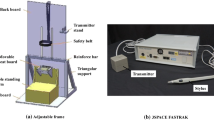Summary
The thermal environment in 42 garages was measured and compared with the results of questionnaires completed by mechanics working in these garages. In the garages studied, the mean air temperature appeared to be rather low. Mean air velocity was moderate (0.17 m/s), with a significant variation among garages (0.07–0.60 m/s). An accurate estimation of the metabolic activity and clothing factor was made. Four current climate standards were selected to evaluate the climate conditions of the investigated garages, i.e. L-index, L-index (comfort), PMV-index and the ASHRAE-index. It appears that the number of garages within the standards acceptable (or recommended) range varies considerably with the standard used. Converting the different standards to the same basis (80% acceptation) does not reduce this variation. These large differences are explained by evaluation of different parameters on which the standards are based. In order to evaluate the thermal environment in garages, Fanger's PMV-index is recommended, as it shows the greatest sensitivity (0.75) combined with a similar positive predictive value (0.65) compared to the other standards. Moreover, this standard incorporates air velocity, which is shown to be crucial in evaluating the thermal environment in garages.
Similar content being viewed by others
References
ASHRAE standard 55-81 (1981) Thermal environmental conditions for human occupancy. American Society of Heating, Refrigerating and Airconditioning Engineers Inc. Atlanta, USA
Berglund LG (1979) Thermal acceptability. ASHRAE transactions II, New York, pp 825–834
Berglund LG (1978) Mathematical models for predicting the thermal comfort response of building occupants. ASHRAE transactions AT78-7a, New York
Design and lay-out of workplaces P-30 (1983) Dutch Labour inspection. Voorburg, The Netherlands
Fanger PO (1972) Thermal comfort. Analysis and applications in environmental engineering. McGraw-Hill, New York
International standard ISO-7730 (1985) Moderate thermal environments-determination of the PMV and PPD indices and specification of the conditions for thermal comfort. International Standards Organisation, Geneva
Kröling P (1985) Gesundheits- und Befindensstörungen in klimatisierten Gebäuden. Verlag W Zuckschwerdt, München-Bern-Wien
Olesen BW (1982) Thermal comfort, technical review. Bruel & Kjaer, Naerum, Denmark
Reinders H (1969) Mensch und Klima. Klima, Klimaphysiologie, Klimatechnik. VDI-Verlag, Düsseldorf
Veiligheidswet (1934) Nederlandse Staatswetten nr.57. Schuurmans en Jordens, Den Haag, The Netherlands
Author information
Authors and Affiliations
Rights and permissions
About this article
Cite this article
Kant, I.J., Bonn, P.J.A. & Notermans, J.V.H. A comparison of current evaluation methods for thermal environment applied to garage work. Int. Arch Occup Environ Heath 61, 115–121 (1988). https://doi.org/10.1007/BF00381615
Received:
Accepted:
Issue Date:
DOI: https://doi.org/10.1007/BF00381615




